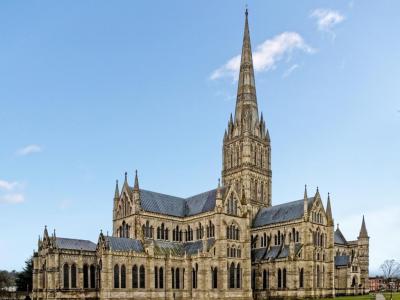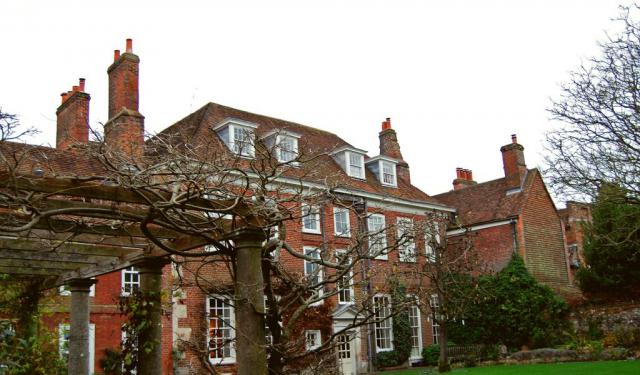Salisbury Cathedral, Salisbury (must see)
At Salisbury’s Cathedral, superlatives flock together like birds on a wire. The tallest spire in Britain? Check: 404 feet. One of only four original copies of the Magna Carta-preserved better than a mummy in a museum? Check. The oldest working clock in Europe, ticking since 1386? Check again. Add to that the largest cathedral cloisters, the biggest cathedral close in Britain, the earliest complete set of choir stalls, and the highest vault in the land. It’s a record-breaking masterpiece, built in just 38 years, from 1220 to 1258-no cranes, no bulldozers, just raw medieval ingenuity.
What set Salisbury Cathedral apart is that it was built on a fresh, empty site. No ruins to work around, no half-finished foundations. The builders had a blank canvas and a clear plan, creating a cohesive design that tied the entire complex together. Begun just five years after the main cathedral was finished, the cloisters mirrored its style with pointed arches, elegant patterns, and matching materials. It was the big debut of Early English Gothic architecture, using narrow stone piers instead of chunky rubble-filled columns. The result was a lighter, brighter interior that let the sun pour in through those lancet windows.
Sure, the structure had its share of “makeovers” over the centuries. James Wyatt and Sir George Gilbert Scott could not resist tweaking things, and some original decorations and chapels did not survive. But Salisbury’s graceful lines and clean symmetry remain intact-still polished, still stunning.
Outside, the cathedral close is now a serene, green expanse. The gravestones are gone, leaving open lawns with benches and shade trees where visitors can picnic or simply admire the view. Just remember, no bikes, booze, ball games, or drones. Instead, enjoy the occasional outdoor art exhibit, or just take in the tranquil atmosphere. It’s history, beauty, and a touch of peace, all wrapped up in one iconic site.
What set Salisbury Cathedral apart is that it was built on a fresh, empty site. No ruins to work around, no half-finished foundations. The builders had a blank canvas and a clear plan, creating a cohesive design that tied the entire complex together. Begun just five years after the main cathedral was finished, the cloisters mirrored its style with pointed arches, elegant patterns, and matching materials. It was the big debut of Early English Gothic architecture, using narrow stone piers instead of chunky rubble-filled columns. The result was a lighter, brighter interior that let the sun pour in through those lancet windows.
Sure, the structure had its share of “makeovers” over the centuries. James Wyatt and Sir George Gilbert Scott could not resist tweaking things, and some original decorations and chapels did not survive. But Salisbury’s graceful lines and clean symmetry remain intact-still polished, still stunning.
Outside, the cathedral close is now a serene, green expanse. The gravestones are gone, leaving open lawns with benches and shade trees where visitors can picnic or simply admire the view. Just remember, no bikes, booze, ball games, or drones. Instead, enjoy the occasional outdoor art exhibit, or just take in the tranquil atmosphere. It’s history, beauty, and a touch of peace, all wrapped up in one iconic site.
Want to visit this sight? Check out these Self-Guided Walking Tours in Salisbury. Alternatively, you can download the mobile app "GPSmyCity: Walks in 1K+ Cities" from Apple App Store or Google Play Store. The app turns your mobile device to a personal tour guide and it works offline, so no data plan is needed when traveling abroad.
Salisbury Cathedral on Map
Sight Name: Salisbury Cathedral
Sight Location: Salisbury, England (See walking tours in Salisbury)
Sight Type: Religious
Guide(s) Containing This Sight:
Sight Location: Salisbury, England (See walking tours in Salisbury)
Sight Type: Religious
Guide(s) Containing This Sight:
Walking Tours in Salisbury, England
Create Your Own Walk in Salisbury
Creating your own self-guided walk in Salisbury is easy and fun. Choose the city attractions that you want to see and a walk route map will be created just for you. You can even set your hotel as the start point of the walk.
Salisbury Introduction Walking Tour
Salisbury’s roots lie in Old Sarum, an Iron Age hillfort located about two miles from today’s city center. The Romans and Saxons each left their mark on this ancient settlement, which became a significant town by the 11th century. After the Norman Conquest in 1066, Old Sarum grew into a fortress town, hosting a castle and becoming the seat of the Salisbury Bishopric in 1075. Yet the site’s... view more
Tour Duration: 1 Hour(s)
Travel Distance: 1.7 Km or 1.1 Miles
Tour Duration: 1 Hour(s)
Travel Distance: 1.7 Km or 1.1 Miles
Historical Houses Tour
Founded more than 800 years ago, Salisbury understandably has a great number of historical, architectural, and cultural gems worthy of a visit. The medieval houses, churches, inns, and hospitals blend harmoniously with the modern sites of the city.
Your exploration of these treasures can be started at Trinity Hospital, a picturesque almshouse founded in the 14th century, offering a glimpse... view more
Tour Duration: 1 Hour(s)
Travel Distance: 1.5 Km or 0.9 Miles
Your exploration of these treasures can be started at Trinity Hospital, a picturesque almshouse founded in the 14th century, offering a glimpse... view more
Tour Duration: 1 Hour(s)
Travel Distance: 1.5 Km or 0.9 Miles
Cathedral Close Tour
Salisbury Cathedral, apart from being renowned as the holder of Britain’s tallest spire, the world’s best preserved original copy of Magna Carta (1215) and Europe’s oldest working clock, is also famous for its Close, the largest in the country, measuring 80 acres (or 32 hectares).
The areas surrounding cathedrals' grounds, sometimes extending for hundreds of meters from the main... view more
Tour Duration: 1 Hour(s)
Travel Distance: 1.2 Km or 0.7 Miles
The areas surrounding cathedrals' grounds, sometimes extending for hundreds of meters from the main... view more
Tour Duration: 1 Hour(s)
Travel Distance: 1.2 Km or 0.7 Miles






